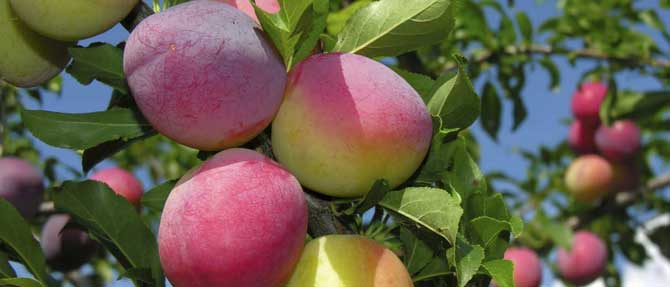Fruit trees are a wonderful addition to any garden. There is nothing quite like the taste of fruit, picked fresh from the tree. Not only do they produce a rewarding crop each year, but are also great as a decorative garden feature, providing spring flowers, fragrance, summer shade, and the birds love them too!
To ensure that your fruit trees remain at their healthiest, it is important to prune each year to encourage new growth. In return, you will be rewarded with a decent haul when fruiting time comes around. The aim of pruning is to encourage renewal of fruiting wood for regular crops of quality fruit, to let light into the tree, to remove diseased parts and to control a tree’s height.
 Our top tips for pruning fruit trees
Our top tips for pruning fruit trees
- Prune in winter when trees are dormant
- Make sure your secateurs are sharp and cut just above each growth bud
- When removing dead or diseased wood, always cut through the healthy tissue below the diseased section
- Paint large cuts with a sealing compound to protect your tree against disease
During early stages of tree development, the main goal is to develop the shape and framework which will support the heavy crops of fruit. When you espalier a fruit tree sometimes you need to bend branches into a position where they are going to be most useful, this often involves tying flexible twigs to a support structure.
Apple Trees: After initial shaping of apple trees, the only pruning necessary is the removal of excess twiggy growth. Apple trees usually produce fruit on spurs, short stubby growths attached to main branches. They continue producing on the same spurs for a number of years. Pears and cherry fruit also grow on spurs and require similar treatment.
Plum Trees: Plum trees produce fruit on the same spurs for several years. Once shape has been established, they require little pruning. Excessive pruning can over stimulate tree growth at the expense of fruit. Remove vertical branching and water shoots’ regularly.
Peach & Nectarine Trees: These trees flower on new wood made the previous summer, so prune hard to encourage new growth. Otherwise, fruit will be produced further and further out on the branches each year. Don’t remove too many flower buds or the current season’s crop will suffer. Flower buds are plump while growth buds are flatter.
Smaller Fruit Trees
There are many new varieties of fruit trees that are smaller growing or naturally dwarf in habit, which makes them ideal for container growing. These trees will still need a suitable pot and regular care for best results. If you require a tree for smaller gardens there are some choices of smaller slower growing rootstocks available in some favourite varieties, such as apple, peach, nectarines and more.
Diseases and spraying
Diseases are spread by wind or moisture and thrive in humid weather. We would recommend burning or disposing of any fallen infected leaves or mummified fruit to minimise the risk of spreading disease. It’s also important to keep your fruit trees in a well-ventilated position and prune to increase air movement.
A couple of preventative sprays of Grosafe Enspray Spraying Oil and Grosafe Free Flow Copper Spray during winter will help prevent disease invading spring leaves, stems and fruit and kill overwintering insects.
For codling moth (on apples) you can use the codling moth pheromone trap, for the guava moth use the guava moth pheromone trap and for other flying and crawling insects use the poison free, sticky traps from easyTRAP.

